Ear as an organ is necessary for the perception of sound and body balance. Cerumen protects the skin of the external auditory canal, assists in cleaning and lubrication. Apart from this it also provides some degree of protection from bacteria, fungi, insects and water. While adequate amount of cerumen is necessary in order to avoid ear infections, excess of it may result in impaction which may cause pain, hearing loss or even dizziness [1]. Ear infection [2], diabetes mellitus [3], hypertension [4] and excessive use of mobile phone for listening to music at high volume [5] all can reduce hearing. Not many studies are available regarding the practice of ear care and its relation to proper hearing. Hence this study was conducted with the aim to assess the community’s knowledge about ear and its functions; attitude towards ear care, ear ache and discharge and practices of cleaning the ear.
To find out the existing knowledge about the ear, to ascertain the level of knowledge of the community regarding ear care, to find out whether some of the common conditions affecting hearing are known and to find out the common practices involved in maintaining ear hygiene.
Materials and Methods
This cross-sectional study was conducted in two tertiary care hospitals in coastal Karnataka in June and July 2014. Five hundred subjects were selected by “convenience” sampling. Sample size was calculated based on the formula,

where Z= confidence level, E = relative error, p = expected frequency, q = 100-p.
Permission to do the study was obtained from the Institutional Ethics Committee. Written informed consent was obtained from the study subjects. Consenting subjects were given a self-administered, semi-structured questionnaire (in local languages), which aims at collecting information about their socio-demographic status, their awareness regarding ear care and other practices.
People were divided into 3 groups based on their age: 18-40 years, 41-60 years and 61-80 years.
People were divided into 3 groups based on their religion: Hindus, Muslim and Christian.
People were divided into 5 groups based on their education background as: 1) illiterates; 2) primary education; 3) secondary education; 4) Pre University; 5) graduates.
Statistical Analysis
Data analysis was done using proportions and association was found using Chi-square test. A statistical package SPSS version 17.0 was used to do the analysis, where p<0.05 was considered as significant. The inference will helped us in determining the class of people, who need to be educated regarding proper ear care, change their attitude and modify their practice of ear care. This will help them avoid suffering from preventable diseases of the ear and improve their overall health.
Results
The study included 225 male and 275 female subjects. Out of 500 subjects, 325 (65%) were Hindus, 130 (26%) were Muslims and 45 (9%) were Christians. Knowledge about the function of the ear across people with different levels of education is shown below in [Table/Fig-1]. The difference in knowledge level between the people with different education level was not statistically significant (p= 0.520).
Education Vs function of the ear (n=500)
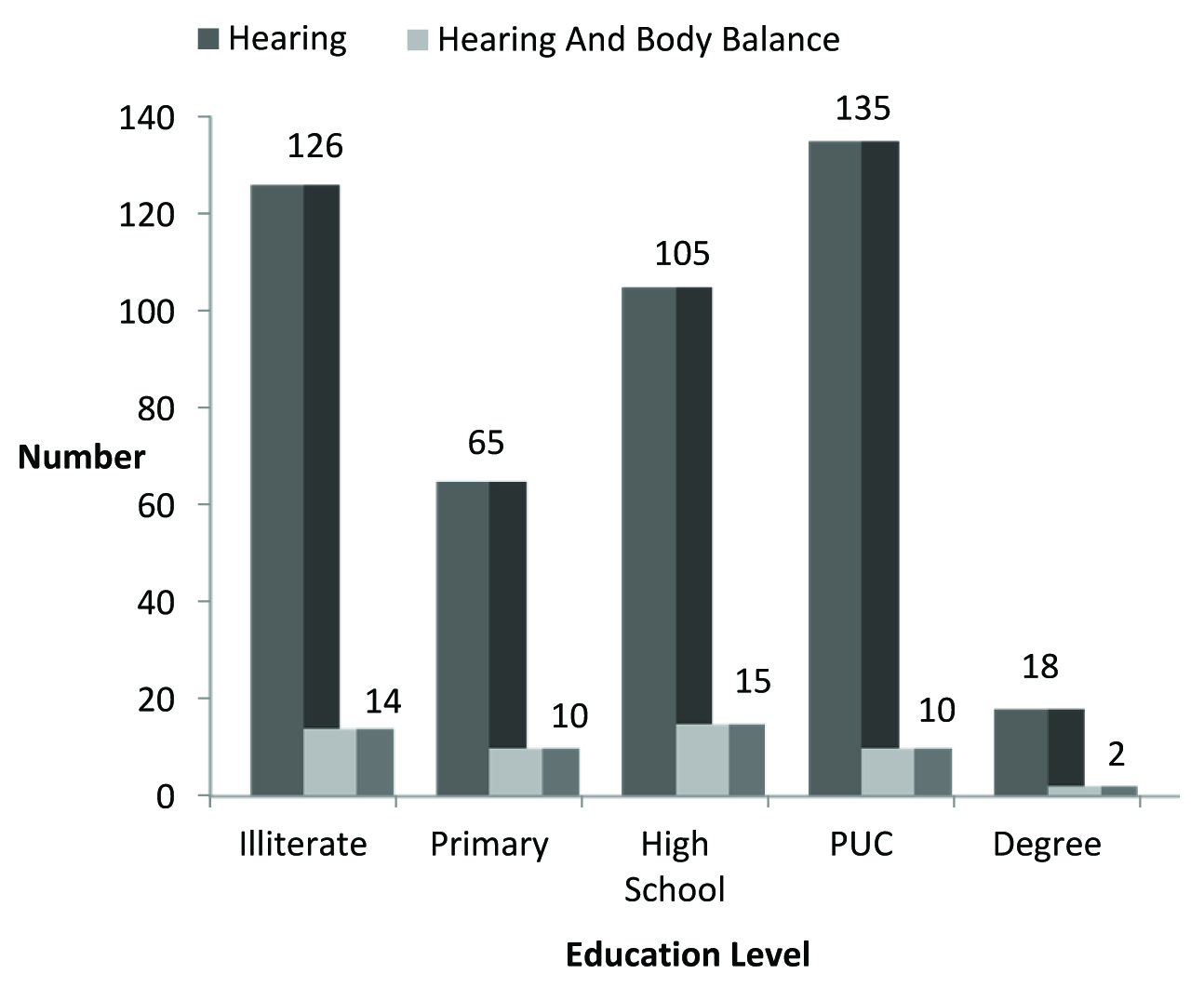
Knowledge about the role of wax in the ear across people with different levels of education is shown below in [Table/Fig-2]. But the difference in knowledge level between the people with different education level was not statistically significant (p = 0.369). Knowledge that, diabetes (DM) and hypertension can reduce hearing across people with different levels of education is shown below in [Table/Fig-3]. The difference in knowledge level between the people with different education level was statistically significant (p = 0.003).
Education Vs role of wax (n= 500)
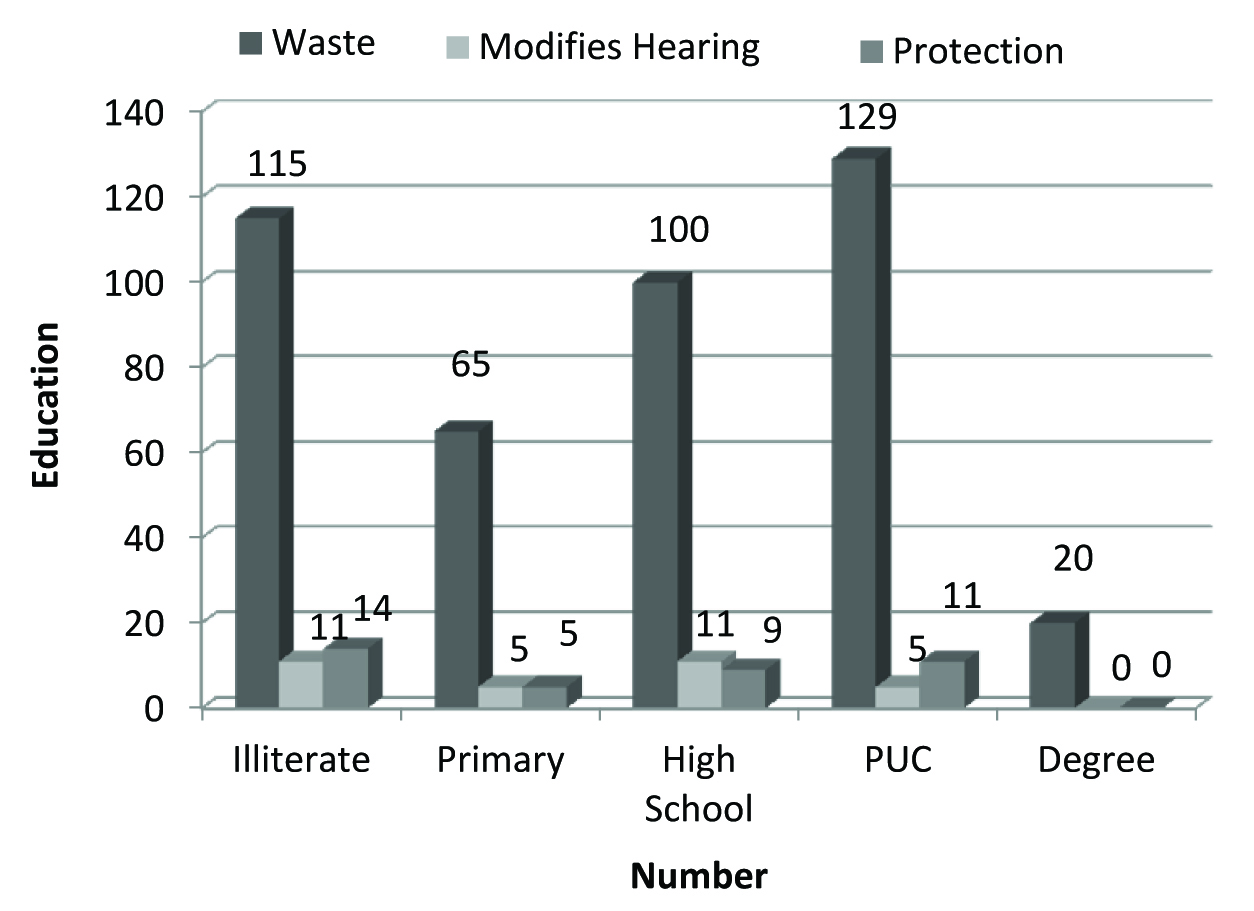
Education Vs effect of Diabetes Mellitus and hypertension (n=500)
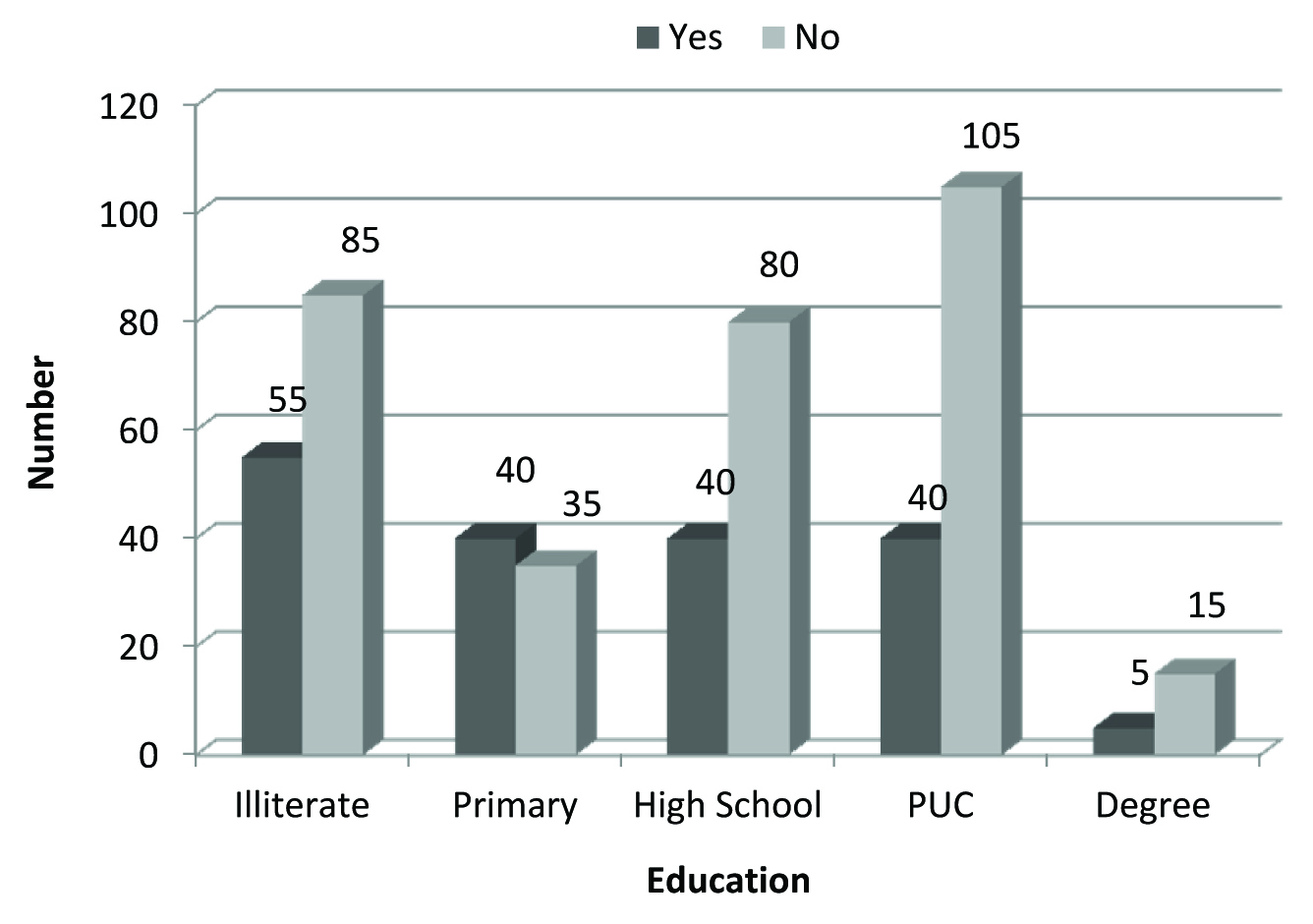
Knowledge across various education groups, about cold or nasal infection affecting the ear is shown in [Table/Fig-4]. The difference in knowledge level between the people with different education level was not statistically significant (p = 0.158). Attitude towards ear pain and discharge across age, religion and education is shown below in [Table/Fig-5]. There was statistically significant difference in the attitude towards ear pain and discharge across various groups of age, religion and education. When there is ear pain and discharge, most of the adults (48.3% to 75%) put drops that are available at home; Christians are less likely to consult a doctor and irrespective of their education background and majority (44.8% to 67.9%) put drops that are available at home. Two hundred and five Hindus, 75 Muslims and 25 Christians were pouring oil in the ear. No statistically significant difference was found between the religions in the practice of pouring oil in the ear (p = 0.417). Majority (77%) of people were pouring oil to reduce itching/pain in ears others (23%) were doing so to keep ear clean. All the 500 people used to pour water in the ear to keep it clean. All the 500 subjects were cleaning inside the ear. The reasons for the same across various education groups are shown below in [Table/Fig-6]. Most common reason to clean inside the ear was to remove wax (87.1%–100%, average 66%). The difference in attitude between the people with different education level was statistically significant (p<0.001). The frequency of practice of cleaning the ear across the education groups is shown below in [Table/Fig-7]. On an average 74% (58.6%–100%) were cleaning the ear daily and the rest at least once a week. The difference in this practice between the people with different education level was statistically significant (p<0.001). The relation between the education and mode of cleaning the ear is shown below in [Table/Fig-8]. Illiterates use sticks (89.3%), whereas educated people (100%) prefer using cotton buds to clean the ears. The difference in the mode of cleaning the ears between the people with different education level was statistically significant (p<0.001).
Education Vs effect of cold or infection in nose (n=500)
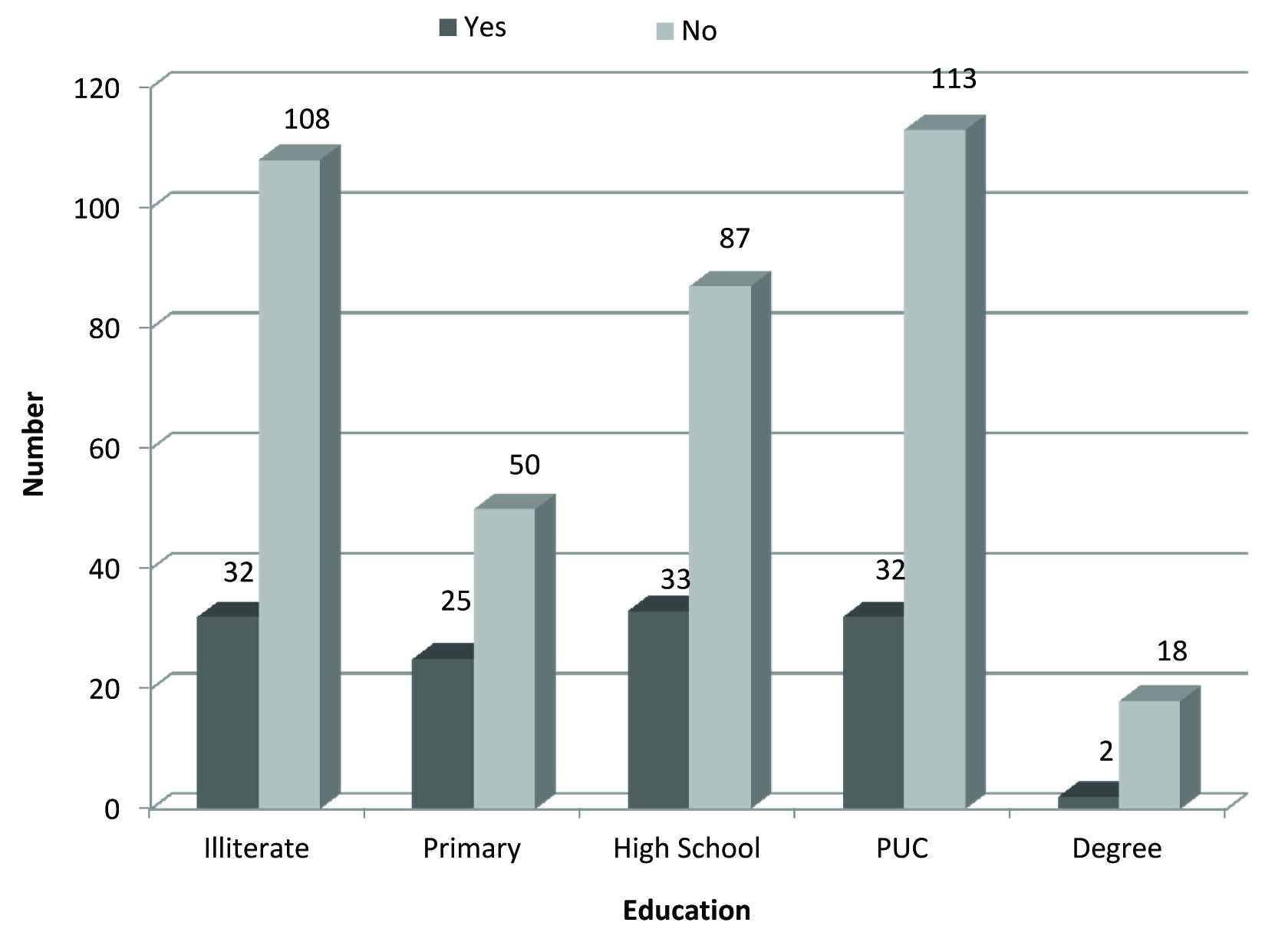
Attitude towards ear pain & discharge across age, religion & education.
| n = 500 | Age (years) | Religion | Education |
|---|
| For all three variables, p <0.003 | 18-40 | 41-60 | 61-80 | H | M | C | 1 | 2 | 3 | 4 | 5 |
|---|
| Put drops that Is at home (%) | 58.8 | 48.3 | 75 | 58.5 | 61.5 | 55.6 | 67.9 | 66.7 | 62.5 | 44.8 | 50 |
| Consult any Doctor (%) | 33.3 | 34.5 | 20 | 35.4 | 30.8 | 0.0 | 25 | 13.3 | 29.2 | 48.3 | 25 |
| Buy drops as per chemist (%) | 7.8 | 17.2 | 5 | 6.2 | 7.7 | 44.4 | 7.1 | 20 | 8.3 | 6.9 | 25 |
Religion: H=Hindus, M=Muslim, C=Christian.
Education: 1= illiterates, 2= primary education, 3= secondary education, 4= Pre University, 5= graduates.
Education Vs reason for cleaning inside the ear (n=500)
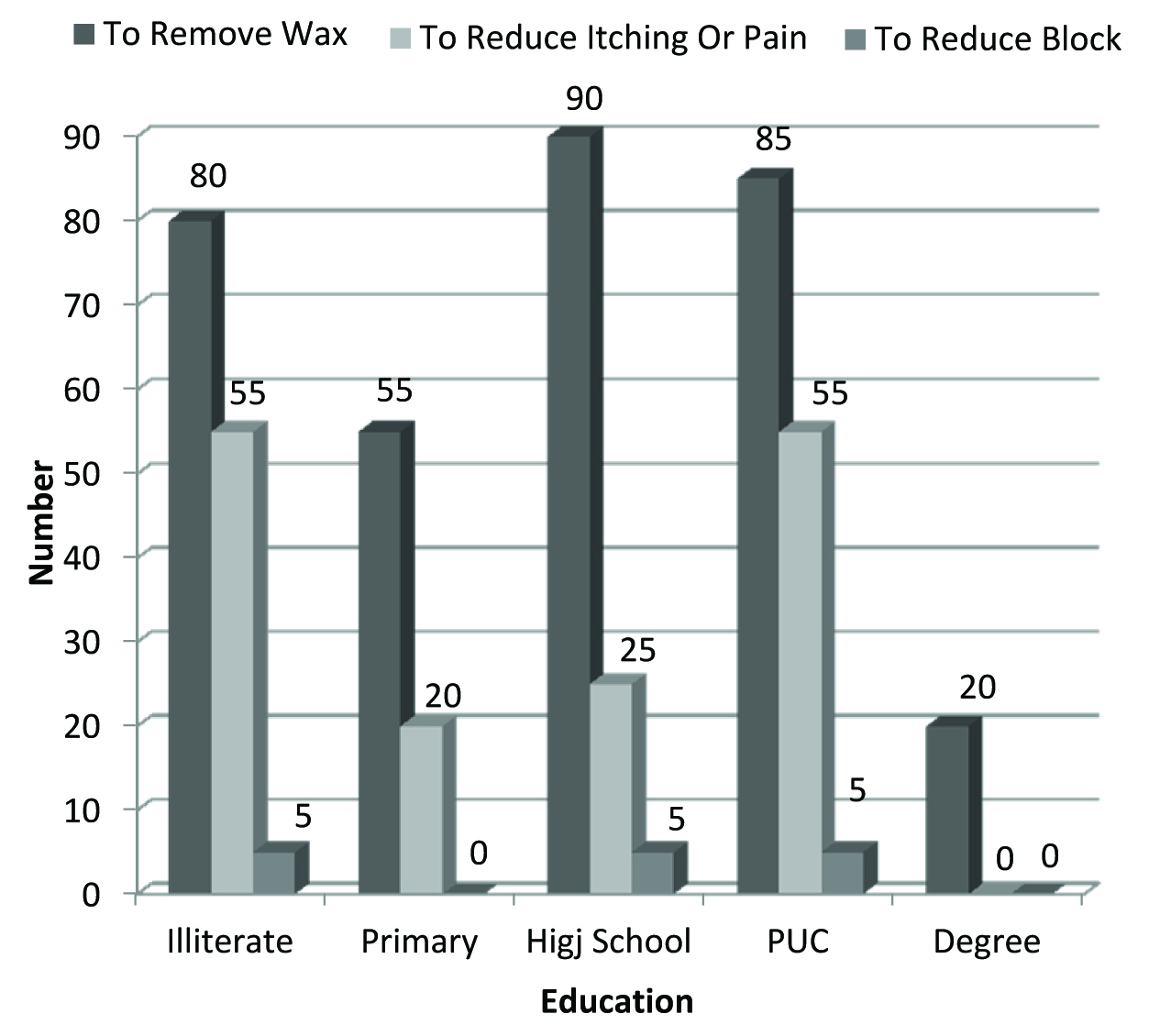
The frequency of cleaning the ear across the education groups (n=500)
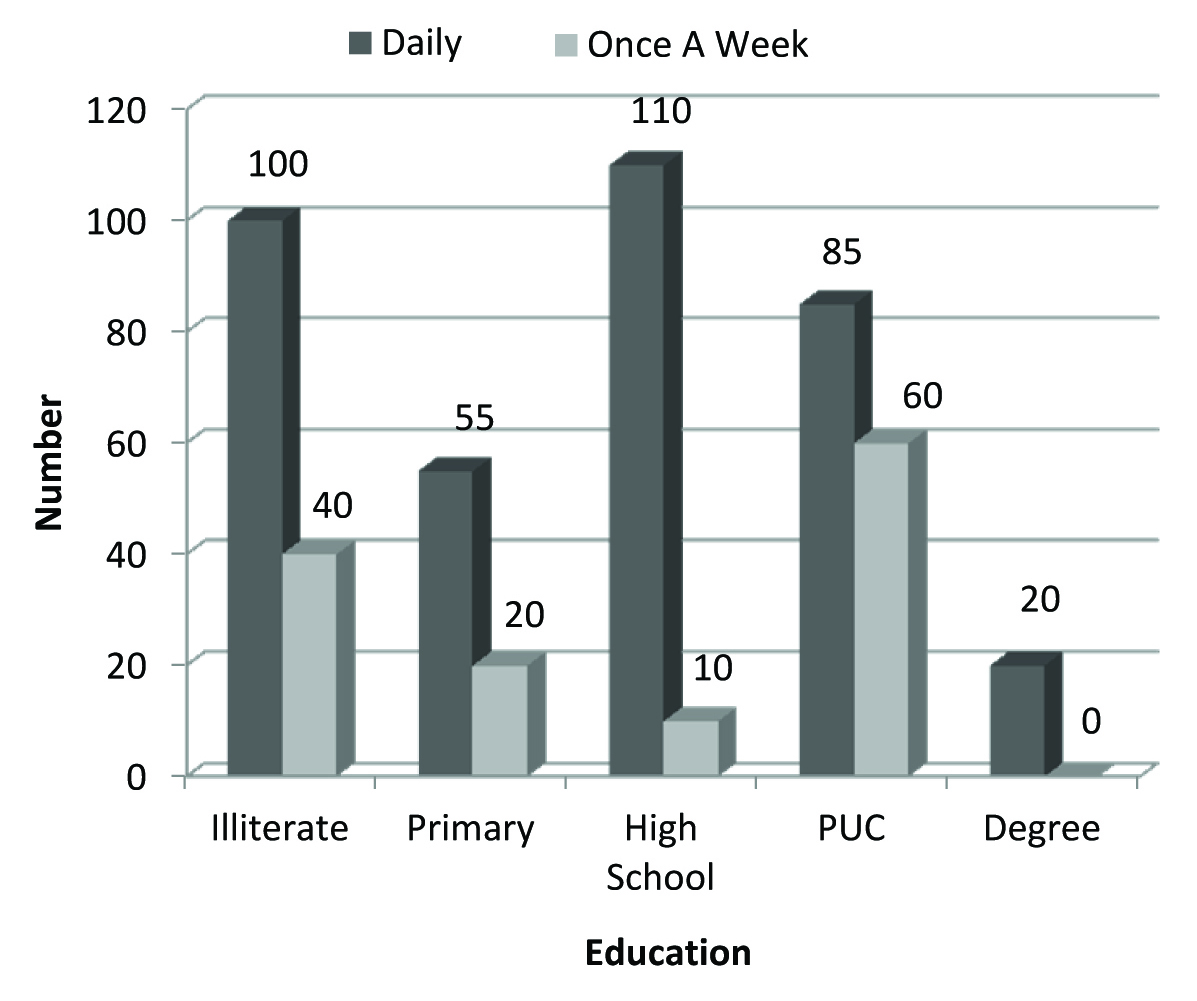
Education Vs mode of cleaning the ear (n=500)
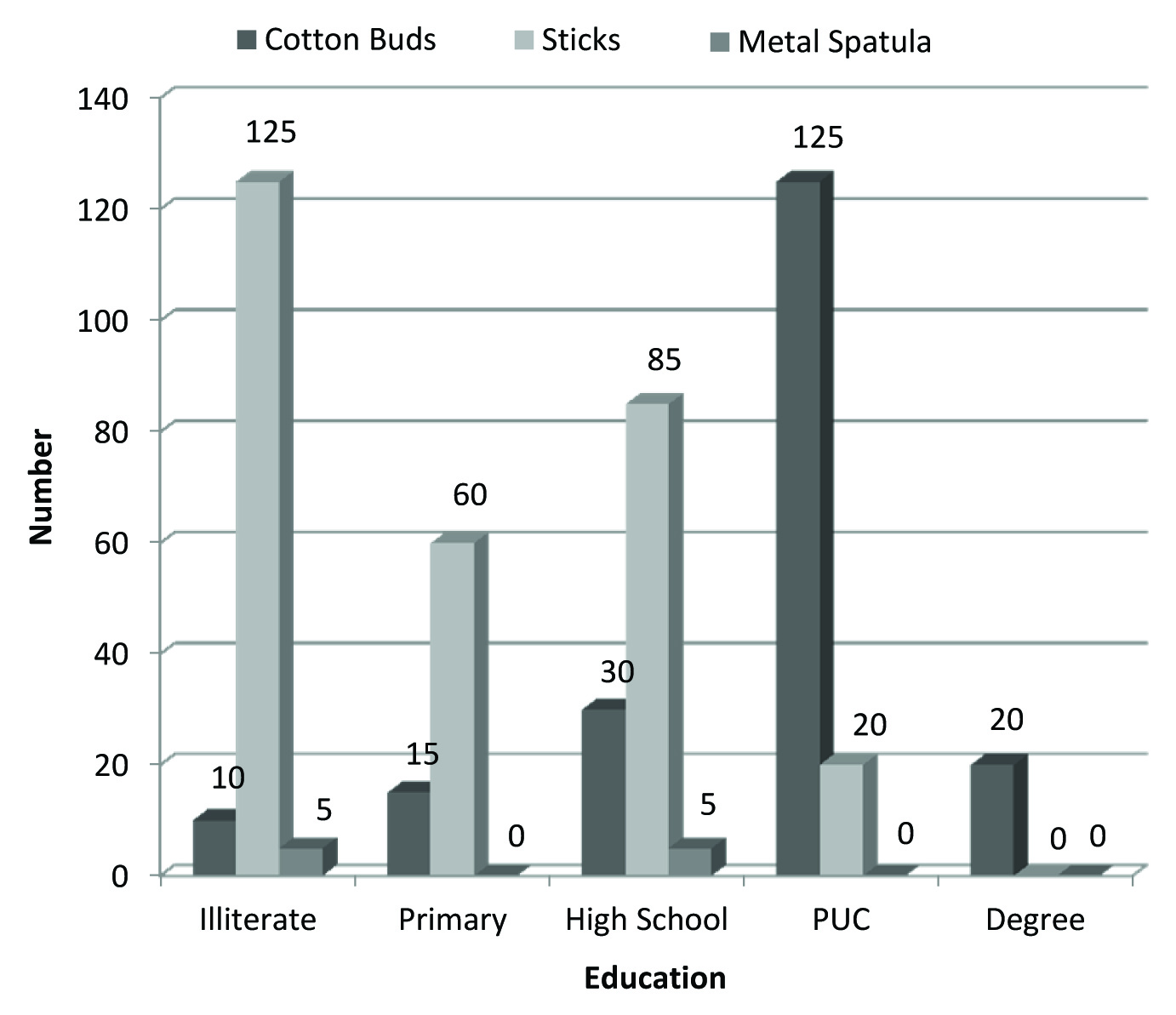
Discussion
Ear as an organ is responsible for the function of hearing and balance mechanism [6]. Our study shows that, 86.7% to 93.1% (average 89.8%) thought that function of the ear is only hearing. Hence, whether illiterate or graduate, general perception of the people is that ear is necessary only for hearing. Nasal infection can cause eustachian tube dysfunction and lead to ear infection [2]. Our study shows that, 66.7% to 90% (average 75.2%) did not know that cold or nasal infection can affect the ear. So irrespective of their general educational background, all people need to be educated about how nasal infection can affect the ears. Diabetic patients have higher prevalence of hearing impairment [3] and there is a significant association between hypertension and hearing loss [4]. Our study shows that, 46.7% to 75% (average 64%) people did not know that DM and Hypertension can cause hearing loss. The difference in knowledge level between the people with different education level was statistically significant (p = 0.003). Awareness about these co-morbidities contributing to hearing loss must be spread in general public.
Our study shows that, when there is ear pain and discharge, most of the adults (48.3% to 75%) put drops that are available at home; Christians are less likely to consult a doctor and irrespective of their education background, majority (44.8% to 67.9%) put drops that are available at home. Hence we should spread the knowledge about the adverse effects of indiscriminatingly using ear drops. To the best of our knowledge, there are no similar studies in the literature.
In our study we found that, using oil for ear itching, pain and to keep the ear clean is a routine practice in costal Karnataka. This seems to be a regional practice and no statistical significant difference was found among people from various religions. To the best of our knowledge, there are no similar studies in the literature.
Natural cleaning process occurs by the process of epithelial migration and is also aided by jaw movement [6]. A study by Alberti et al., suggested that, the habit of self-ear cleaning should be discouraged as it is slow otologic poison with an attendant long term effect. They studied 372 subjects of which, about 90% of the subjects interviewed did self-ear cleaning and over 90% believed ear should be cleaned to remove wax, because of itching in over 50% while a few was due to cosmetic reason. Cotton bud was the commonest material used for cleaning. About one-third of the subject had formed the habit unconsciously over 10 years. The entire subjects interviewed had their ear examined; about 27% had ear discharge, wax impaction in 22% and foreign body 12% [7]. In our study, all the 500 subjects were cleaning their ear canals. Most common reason to clean inside the ear was to remove wax (87.1% –100%, average 66%), another 31% to reduce itching or pain and 3% to reduce the block sensation in the ear. A total of 58.6%-100% (average 74%) were cleaning the ear daily and the rest at least once a week. Illiterates used sticks (89.3%), whereas educated people (100%) preferred using buds to clean the ears. But as compared to study by Alberti et al., we did not perform examination of the ears to look for abnormalities [8].
Limitations
Our study is though rare and unique, it has few limitations. No randomization was followed in the selection of the subjects. The questionnaire was not validated.
Conclusion
General perception of the people is that ear is necessary only for hearing. Majority (75.2%) did not know that cold or nasal infection can affect the ear and 64% people did not know that DM and hypertension can cause hearing loss. When there is ear pain and discharge, most of the adults (48.3% to 75%) put drops that are available at home. Pouring oil into the ears and cleaning inside the ear canals is routinely practiced in costal Karnataka.
Religion: H=Hindus, M=Muslim, C=Christian.
Education: 1= illiterates, 2= primary education, 3= secondary education, 4= Pre University, 5= graduates.